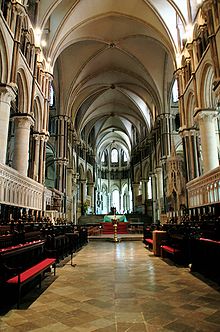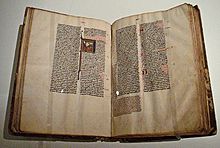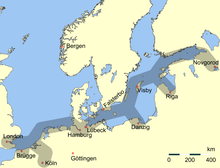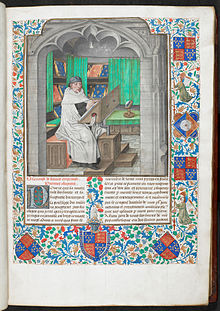The Twelfth Century Renaissance Made It Possible to Speak of Europe as a Reading Public Because of

The Renaissance of the 12th century was a catamenia of many changes at the outset of the High Eye Ages. It included social, political and economic transformations, and an intellectual revitalization of Western Europe with strong philosophical and scientific roots. These changes paved the way for later achievements such as the literary and artistic movement of the Italian Renaissance in the 15th century and the scientific developments of the 17th century.[1]
Medieval renaissances [edit]
The background for the rebirth of learning was laid by the process of political consolidation and centralization of the monarchies of Europe.[2] This process of centralization began with Charlemagne (768–814) King of the Franks and afterwards (800–814), Holy Roman Emperor. Charlemagne's inclination towards education, which led to the creation of many new churches and schools where students were required to learn Latin and Greek, has been called the Carolingian Renaissance.[ commendation needed ]
A second "renaissance" occurred during the reign of Otto I (The Great) (936–973) Male monarch of the Saxons[iii] and from 962 onwards Emperor of the Holy Roman Empire. Otto was successful in unifying his kingdom and asserting his right to appoint bishops and archbishops throughout his kingdom. Otto's assumption of this ecclesiastical power brought him into close contact with the best educated and ablest class of men in his kingdom.[four] Considering of this close contact many new reforms were introduced in the Saxon Kingdom and in the Holy Roman Empire. Thus, Otto's reign has been called the Ottonian Renaissance.
Therefore, the Renaissance of the 12th century has been identified as the third and final of the medieval renaissances. Yet the renaissance of the twelfth century was far more thoroughgoing than those renaissances that preceded in the Carolingian or in the Ottonian periods.[v] Indeed, Charlemagne's Carolingian Renaissance was actually more than particular to Charlemagne himself, and was really more of a "veneer on a changing lodge"[6] than a true renaissance springing up from club, and the same might be said of the Ottonian Renaissance.
Historiography [edit]
Charles H. Haskins was the offset historian to write extensively near a renaissance that ushered in the High Center Ages starting about 1070. In 1927, he wrote that:
[The 12th century in Europe] was in many respects an historic period of fresh and vigorous life. The epoch of the Crusades, of the rise of towns, and of the primeval bureaucratic states of the West, it saw the culmination of Romanesque art and the ancestry of Gothic; the emergence of the vernacular literatures; the revival of the Latin classics and of Latin verse and Roman law; the recovery of Greek science, with its Standard arabic additions, and of much of Greek philosophy; and the origin of the first European universities. The 12th century left its signature on college education, on the scholastic philosophy, on European systems of law, on architecture and sculpture, on the liturgical drama, on Latin and vernacular poesy...[seven]
British art historian Kenneth Clark wrote that Western Europe'due south first "bully historic period of civilisation" was prepare to begin around the year 1000. From 1100, he wrote, monumental abbeys and cathedrals were constructed and decorated with sculptures, hangings, mosaics and works belonging to ane of the greatest epochs of art and providing stark contrast to the monotonous and cramped conditions of ordinary living during the period. Abbot Suger of the Abbey of St. Denis is considered an influential early patron of Gothic architecture and believed that love of beauty brought people closer to God: "The ho-hum listen rises to truth through that which is material". Clark calls this "the intellectual background of all the sublime works of art of the next century and in fact has remained the basis of our belief of the value of art until today".[8]
Translation movement [edit]

The translation of texts from other cultures, specially ancient Greek works, was an important aspect of both this 12th-Century Renaissance and the latter Renaissance (of the 15th century), only to say that the relevant difference was that Latin scholars of the earlier period focused almost entirely on translating and studying Greek and Arabic works of natural scientific discipline, philosophy and mathematics, while the later Renaissance focus was on literary and historical texts is inaccurate, since some of the most pregnant Greek translations of the 15th century were those by Mauricio Ficino, including several works of Plato and the NeoPlatonists, equally well as a highly significant translation of the Corpus Hermeticum. These were works of Pythagorean and Platonic spirituality and philosophy of far more than importance to later philosophical and religious debate than the translations of the 12th century.
Trade and commerce [edit]

Primary trading routes of the Hanseatic League
The era of the Crusades brought large groups of Europeans into contact with the technologies and luxuries of Byzantium for the get-go fourth dimension in many centuries. Crusaders returning to Europe brought numerous small luxuries and souvenirs with them, stimulating a new appetite for trade. The rising Italian maritime powers such as Genoa and Venice began to monopolize trade between Europe, Muslims and Byzantium via the Mediterranean, having developed advanced commercial and financial techniques; cities like Florence became major centers of this financial industry.[9]
In Northern Europe, the Hanseatic League was founded in the twelfth century, with the foundation of the metropolis of Lübeck in 1158–1159. Many northern cities of the Holy Roman Empire became Hanseatic cities, including Hamburg, Stettin, Bremen and Rostock. Hanseatic cities outside the Holy Roman Empire were, for instance, Bruges, London and the Polish city of Danzig (Gdańsk). In Bergen and Novgorod the league had factories and middlemen. In this period the Germans started colonizing Eastern Europe beyond the Empire, into Prussia and Silesia.
In the mid 13th century, the "Pax Mongolica" re-invigorated the land-based trade routes between China and West Asia that had fallen fallow in the 9th and tenth centuries. Following the Mongol incursion into Europe in 1241, the Pope and some European rulers sent clerics as emissaries and/or missionaries to the Mongol court; these included William of Rubruck, Giovanni da Pian del Carpini, Andrew of Longjumeau, Odoric of Pordenone, Giovanni de Marignolli, Giovanni di Monte Corvino, and other travelers such as Niccolò da Conti. While the accounts of Carpini et al were written in Latin equally letters to their sponsors, the account of the later Italian traveller Marco Polo, who followed his father and uncle as far as China, was written first in French c.1300 and later in other popular languages, making it relatively accessible to larger groups of Europeans.
Science [edit]

Medieval scholars sought to understand the geometric and harmonic principles past which God created the universe.[10]

Miniature copying of a manuscript in a scriptorium
Afterwards the collapse of the Western Roman Empire, Western Europe had entered the Eye Ages with bully difficulties. Autonomously from depopulation and other factors, most classical scientific treatises of classical antiquity, written in Greek or Latin, had get unavailable or lost entirely. Philosophical and scientific teaching of the Early on Eye Ages was based upon the few Latin translations and commentaries on ancient Greek scientific and philosophical texts that remained in the Latin West, the study of which remained at minimal levels. Only the Christian church maintained copies of these written works, and they were periodically replaced and distributed to other churches.
This scenario changed during the renaissance of the 12th century. For several centuries, popes had been sending clerics to the various kings of Europe.[ citation needed ] Kings of Europe were typically illiterate.[ citation needed ] Literate clerics would be specialists of some subject or other, such every bit music, medicine or history etc., otherwise known every bit Roman cohors amicorum, the root of the Italian word corte 'court'. As such, these clerics would go part of a king'southward retinue or court, educating the rex and his children, paid for by the pope, whilst facilitating the spread of knowledge into the Heart Ages.[ commendation needed ] The church maintained classic scriptures in scrolls and books in numerous scriptoria across Europe, thus preserving the classic knowledge and allowing access to this important information to the European kings. In return, kings were encouraged to build monasteries that would act as orphanages, hospitals and schools, benefiting societies and somewhen smoothing the transition from the Heart Ages.
The increased contact with the Islamic world in Muslim-dominated Iberia and Southern Italy, the Crusades, the Reconquista, equally well as increased contact with Byzantium, allowed Western Europeans to seek and translate the works of Hellenic and Islamic philosophers and scientists, especially the works of Aristotle. Several translations were made of Euclid but no extensive commentary was written until the middle of the 13th century.[xi]
The development of medieval universities allowed them to aid materially in the translation and propagation of these texts and started a new infrastructure which was needed for scientific communities. In fact, the European university put many of these texts at the middle of its curriculum,[12] with the result that the "medieval university laid far greater emphasis on science than does its modern counterpart and descendent."[13]
At the beginning of the 13th century, there were reasonably accurate Latin translations of some ancient Greek scientific works, though not of the Mechanika, an accurate translation of Euclid, or of the scientific advances of the NeoPlatonists. But those texts that were available were studied and elaborated, leading to new insights into the nature of the universe. The influence of this revival is evident in the scientific piece of work of Robert Grosseteste and the NeoPlatonism of Bernardus Silvestris (?1085-?1178).[14]
Technology [edit]

Detail of a portrait of Hugh de Provence, painted by Tommaso da Modena in 1352
During the High Center Ages in Europe, there was increased innovation in means of production, leading to economic growth.
Alfred Crosby described some of this technological revolution in The Measure out of Reality : Quantification in Western Europe, 1250-1600 and other major historians of applied science have also noted information technology.
- The earliest written record of a windmill is from Yorkshire, England, dated 1185.
- Paper manufacture began in Spain around 1100, and from there it spread to France and Italy during the 12th century.
- The magnetic compass aided navigation, attested in Europe in the belatedly 12th century.
- The astrolabe returned to Europe via Islamic Kingdom of spain.
- The West'south oldest known depiction of a stern-mounted rudder can be establish on church carvings dating to effectually 1180.
Latin literature [edit]
The early twelfth century saw a revival of the study of Latin classics, prose, and poesy before and independent of the revival of Greek philosophy in Latin translation. The Cathedral schools at Chartres, Orleans, and Canterbury were centers of Latin literature staffed past notable scholars. John of Salisbury, secretarial assistant at Canterbury, became the bishop of Chartres. He held Cicero in the highest regard in philosophy, linguistic communication, and the humanities. Latin humanists possessed and read almost all the Latin authors we accept today—Ovid, Virgil, Terence, Horace, Seneca, Cicero. The exceptions were few—Tacitus, Livy, Lucretius. In poetry, Virgil was universally admired, followed by Ovid.[15]
Like the earlier Carolingian revival, the 12th-century Latin revival would not be permanent. While religious opposition to pagan Roman literature existed, Haskins argues that "it was not religion but logic" in item "Aristotle's New Logic toward the middle of [the 12th] century [that] threw a heavy weight on the side of dialectic ..." at the expense of the letters, literature, oratory, and poetry of the Latin authors. The nascent universities would become Aristotelean centers displacing the Latin humanist heritage[16] until its last revival past Petrarch in the 14th century.
Roman law [edit]
| | This department needs expansion. You can help by adding to it. (July 2013) |
The study of the Digest was the showtime step to the revival of Roman legal jurisprudence and the establishment of Roman law as the basis of ceremonious law in continental Europe. The Bologna University was Europe's heart of legal scholarship during this period.
Scholasticism [edit]
A new method of learning called scholasticism developed in the late 12th century from the rediscovery of the works of Aristotle; the works of medieval Muslims and Jews influenced past him, notably Maimonides, Avicenna (see Avicennism) and Averroes (see Averroism). The great scholastic scholars of the 13th century were Albertus Magnus, Bonaventure and Thomas Aquinas. Those who skillful the scholastic method defended Roman Catholic doctrines through secular study and logic. Other notable scholastics ("schoolmen") included Roscelin and Peter Lombard. One of the main questions during this time was the problem of the universals. Prominent non-scholastics of the fourth dimension included Anselm of Canterbury, Peter Damian, Bernard of Clairvaux, and the Victorines.[17]
Arts [edit]
The 12th-century renaissance saw a revival of involvement in poesy. Writing mostly in their own native languages, contemporary poets produced significantly more than work than those of the Carolingian Renaissance. The subject thing varied wildly across epic, lyric, and dramatic. Meter was no longer bars to the classical forms and began to diverge into newer schemes. Additionally, the division between religious and secular poetry became smaller.[xviii] In particular, the Goliards were noted for profane parodies of religious texts.[xix]
These expansions of poetic form contributed to the rising of colloquial literature, which tended to prefer the newer rhythms and structures.[20]
Come across also [edit]
- Continuity thesis
- Crunch of the Late Middle Ages
References [edit]
Citations [edit]
- ^ (Bauer 2013, p. 1 – preface)
- ^ (Hoyt 1976, p. 329)
- ^ (Hoyt 1976, p. 197)
- ^ (Hoyt 1976, p. 198)
- ^ (Hoyt 1976, p. 366)
- ^ (Hoyt 1976, p. 164)
- ^ (Haskins 1927, p. eight – introduction)
- ^ Civilisation (Telly serial)
- ^ Irving Woodworth Raymond, Robert Sabatino Lopez. Medieval Trade in the Mediterranean World. Columbia Academy Printing.
- ^ The compass in this 13th-century manuscript is a symbol of God'south act of Cosmos.
* Thomas Woods, How the Catholic Church Built Western Civilization, (Washington, DC: Regenery, 2005), ISBN 0-89526-038-7 - ^ Robert Robert Louis Benson; Giles Constable; Ballad Carol Dana Lanham, eds. (1991). Renaissance and Renewal in the Twelfth Century. Harvard University Press. p. 471.
- ^ Toby Huff, Rise of early modern science second ed. p. 180-181
- ^ Edward Grant, "Science in the Medieval University", in James Chiliad. Kittleson and Pamela J. Transue, ed., Rebirth, Reform and Resilience: Universities in Transition, 1300-1700, Columbus: Ohio Land University Printing, 1984, p. 68
- ^ Jane E. House (Jump 2013). "Learning How Much 12th Century Scientists knew and How They Knew It". Page. Graduate Centre of the Urban center University of New York: 2.
- ^ Charles Homer Haskins. The Renaissance of the Twelfth Century. Cambridge: Harvard University Press, 1927. Chapter I-Iv
- ^ (Haskins 1927, pp. 98–99)
- ^ Gilson, Etienne (1991). The Spirit of Medieval Philosophy (Gifford Lectures 1933-35). Notre Dame, IN: Academy of Notre Matriarch Printing. p. 490. ISBN978-0-268-01740-8.
- ^ (Haskins 1927, pp. 153–158)
- ^ (Haskins 1927, pp. 183–185)
- ^ (Haskins 1927, p. 190)
Bibliography [edit]
- Bauer, Susan Wise (2013), The History of the Renaissance World: From the Rediscovery of Aristotle to the Conquest of Constantinople, New York: West. W. Norton & Company, ISBN978-0-3930-5976-two
- Benson, Robert L., Giles Constable, and Carol D. Lanham, eds. (1982). Renaissance and Renewal in the Twelfth Century. Cambridge: Harvard University Press.
- Haskins, Charles Homer (1927), The Renaissance of the 12th Century, Cambridge: Harvard Academy Printing, ISBN978-0-6747-6075-2
- Hoyt, Robert S.; Chodorow, Stanley (1976), Europe in the Middle Ages (3 ed.), New York: Harcourt, Brace Jovanovich, Inc., ISBN978-0-1552-4712-3
External links [edit]
- A cursory analysis of Haskins, Renaissance of the Twelfth Century
- A bibliography of the 12th-century renaissance
goodridgetwout1977.blogspot.com
Source: https://en.wikipedia.org/wiki/Renaissance_of_the_12th_century
0 Response to "The Twelfth Century Renaissance Made It Possible to Speak of Europe as a Reading Public Because of"
Mag-post ng isang Komento